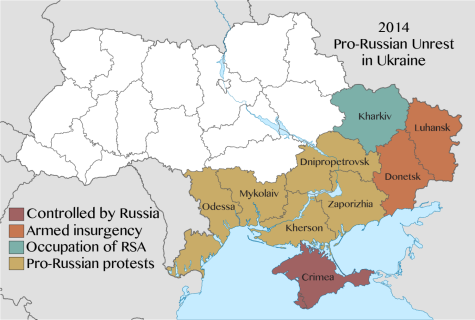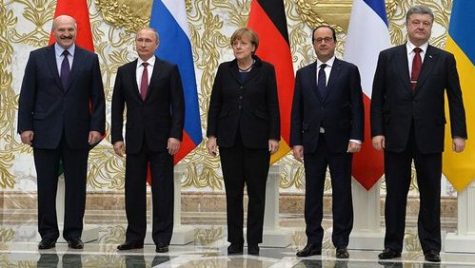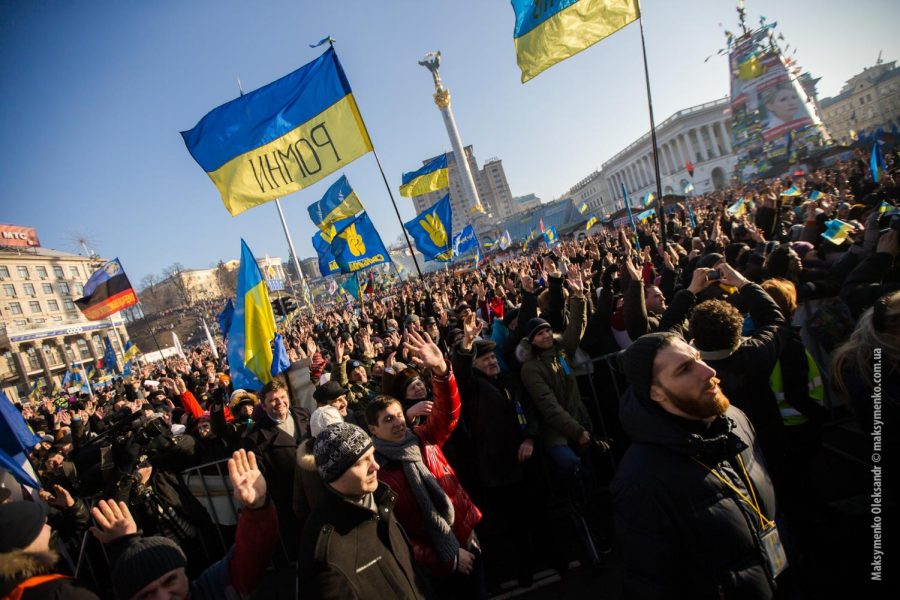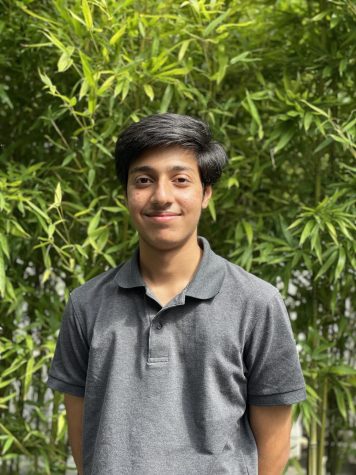The Ongoing Crisis in Ukraine
January 14, 2022
On November 3 of 2021, Reuters reported that Ukrainian Defense services were fearful of a full-scale invasion along the country’s eastern borders. Their intelligence had estimated nearly 90,000 Russian troops amassed near the border between the two nations.
The following month saw that estimate increase to 100,000, coupled with the erection of essential military supply lines in the region, which raised alarm bells across much of the West. A US state department official was quoted by the Washington Post saying a Russian invasion could begin “as soon as early 2022.”
While Russian aggression in the region has been a regular occurrence since 2014, the current military buildup stands out for several reasons. First, the Kremlin has deployed more than double the number of troops along the border than it had in the Spring of 2021 and increased the number of military exercises conducted.
Second, statements made by Russian President Vladimir Putin in the past year have alluded to Moscow’s increased interest in Ukraine and its citizens. In a statement made in July, Putin referred to the centuries-old “spiritual, human and civilizational ties” between the two countries and their citizens as “one people.” The speech also represents the Russian perspective of their relations — historical ties, trade agreements, and cultural association — and asserts that “true sovereignty of Ukraine is only possible in partnership with Russia.”
Yet, Russia’s involvement in Ukraine is not new, with the current standoff being the result of a conflict stretching back to 2014.
Background
A former Soviet state, Ukraine has been an independent nation since 1991. From then on, Ukraine’s political climate has resembled its geography — halfway between Russia and the rest of Europe. Two-thirds of the country’s citizens speak Ukrainian and are concentrated in the western regions of the nation, while the Russian-speaking third is primarily in the east and Crimea.
This division has led to differing opinions within the nation on whether the Ukrainian government should follow a pro-Russia policy or one that leans more towards the EU and the US. The differences have created tensions among Ukrainian citizens that came to a head in 2013.
Euromaidan Protests and Revolution of Dignity:
In November of 2013, protesters took to the streets across the nation, demanding that the national government listen to their needs. President Viktor Yanukovych had refused to sign an Association Agreement with the EU that was years in the making. The agreement would have increased Ukraine’s political and trade association with the EU.
The government cited the “complex economic situation” in Ukraine and argued that the deal would do serious damage to the economy. It would shake Ukraine’s relationship with members of the Commonwealth of Independent States (CIS), an organization that includes Russia — Ukraine’s primary gas provider.
The protesters argued that Yanukovych was violating the will of the people and folding under economic pressure from Russia, a claim denied by both Russia and the Yanukovych government. The epicenter of the protests was at Independence Square in Kyiv, also known as the Maidan.
On 18 February 2014, violence broke out. The police had ordered protesters to disperse and clear the Maidan; when protesters refused, the barricades were broken, leading to clashes between protesters and police forces. The riot police used stun guns, while protesters used Molotov cocktails, leaving more than a hundred dead in total. The international community pressured Ukraine to bring an end to what one BBC reporter on the ground called “utter chaos.”
Under pressure from the nation, President Yanukovych was forced to flee (to Russia), allowing an interim government to be formed.
Annexation of Crimea
Crimea, the semi-autonomous region of Ukraine neighboring the Black Sea, is ethnically Russian, with more than 75 percent of its population speaking Russian. It also housed a key military base for the Russian Armed Forces.
Soon after Yanukovych was ousted, bands of gunmen — later identified as unmarked Russian troops — began appearing in Crimea. In the following weeks, a referendum was held, wherein 95.5% of voters voted for secession from Ukraine and union with Russia.
The referendum, which most Pro-Kyiv Crimeans had boycotted, was deemed illegitimate by Ukraine and much of the international community. Despite this, while addressing the Russian parliament, Putin spoke of Crimea as “an inalienable part of Russia,” following which Moscow confirmed the annexation of Crimea.
Counter-revolution and War in the East
Soon after the Russian annexation of Crimea, separatist rebels in eastern Ukraine began to make their presence felt. The rebels were unhappy with the ouster of President Yanukovych and demanded independence from Ukraine. In this manner, the underlying tensions in the country began boiling over.
The armed rebels took control of the Donbas region — which includes towns like Sloviansk and Donetsk — and proclaimed a “people’s republic.” Unwilling to negotiate with the separatists, Kyiv sent the Ukrainian military into the region.
Since the outbreak of violence in 2014, Ukraine and the West have maintained that the rebels are backed by Moscow and have pointed to the use of Russian military equipment by the rebels as evidence. Russia, meanwhile, has denied involvement on its part while stating that it is, however, concerned with the state of affairs in Ukraine.
Amid the violence, the region made international headlines once more when Malaysian Airlines Flight MH17, carrying 283 passengers and 15 crew members, crashed under mysterious circumstances in the region. It appeared that the separatists had gunned down the passenger flight.
Investigations conducted by Dutch authorities were able to precisely determine the point of impact and the warhead used. In 2018, they concluded that Russian military forces had provided the separatists with the necessary Buk missile system (a simulation of the explosions was provided as well.) This prompted the Netherlands and Australia to hold Russia responsible for the crash and increased the international pressure on Moscow.

Aftermath
In the years following the outbreak of war, the Minsk Agreements were signed. The first (Minsk I) was signed in 2014 and outlined a ceasefire deal between the separatists and Kyiv. The agreement provided for prisoner exchanges and granted both sides humanitarian aid.
The second agreement (Minsk II), signed in 2015, was broader, including Russia, the Organization for Security and Cooperation in Europe (OSCE), and the warring parties. The agreement provided for constitutional reforms in Ukraine, particularly decentralization and increased autonomy for the Donbas region. It also ordered the withdrawal of any foreign military personnel or equipment, something Moscow has not followed through on as it has denied the existence of such in the region.

The Current Standoff
Despite the Minsk Agreements, the conflict has continued, with the death toll rising from 2,600 (at the time of the agreements) to over 14,000 by late 2021. The conflict has also outlined Russia’s ambitions in the region, with commentators recognizing Moscow’s aggression as a direct challenge to the United States’ authority in the area.
The Putin government has been emboldened by the gradual rollback of US interests abroad and the increasing discontent within America. Despite the imposition of US sanctions in 2014 and the threat of further restrictions under the Biden Administration, Moscow — backed by an estimated war chest of $620 billion — has stayed its course.
With the threat of a full-scale invasion looming, the US and the West find themselves in a high-wire balancing act — diplomatic actions seem ineffective, and direct military assistance would see further bloodshed in the region. All eyes are on D.C. for the next step.




















